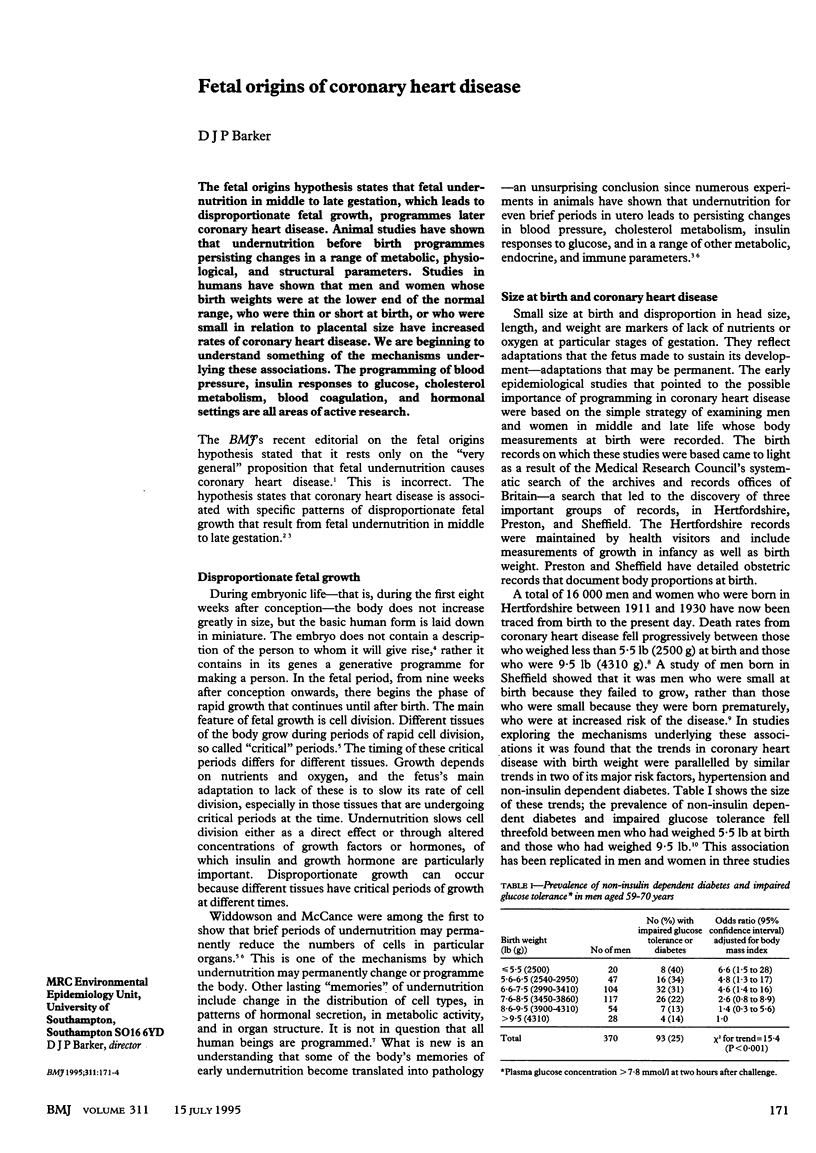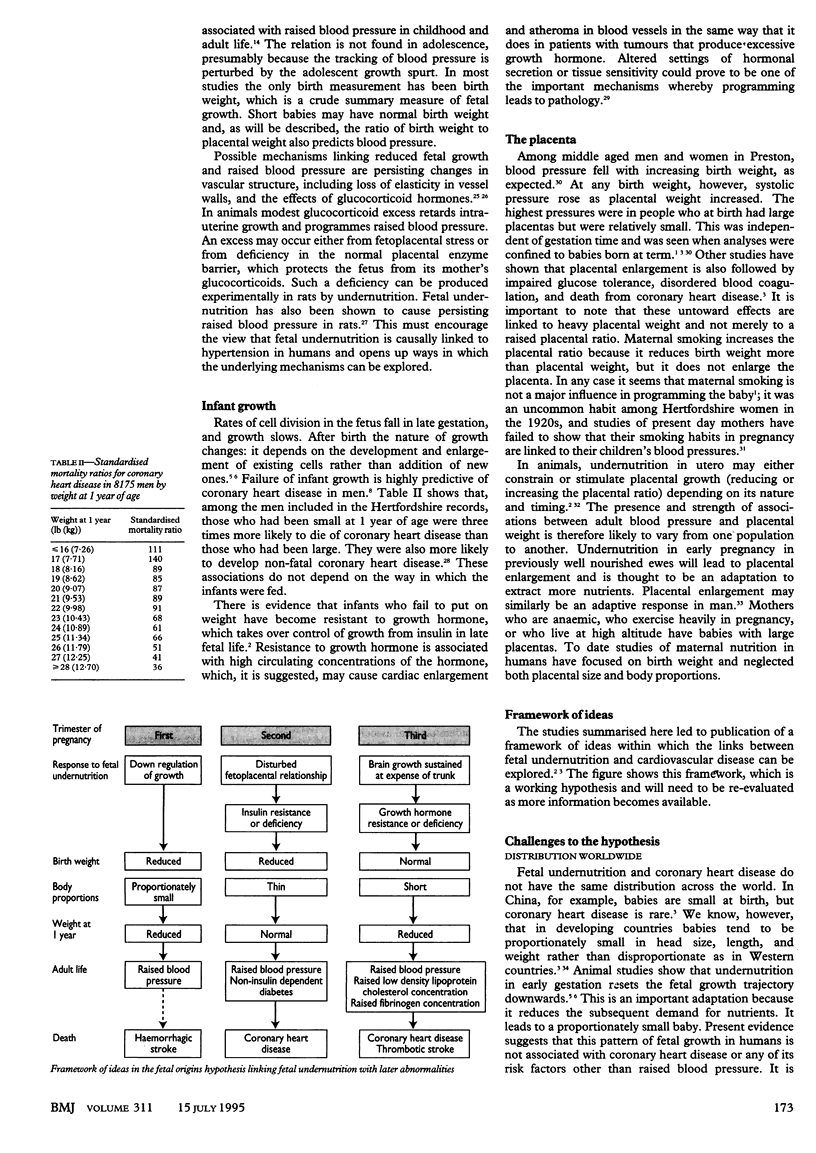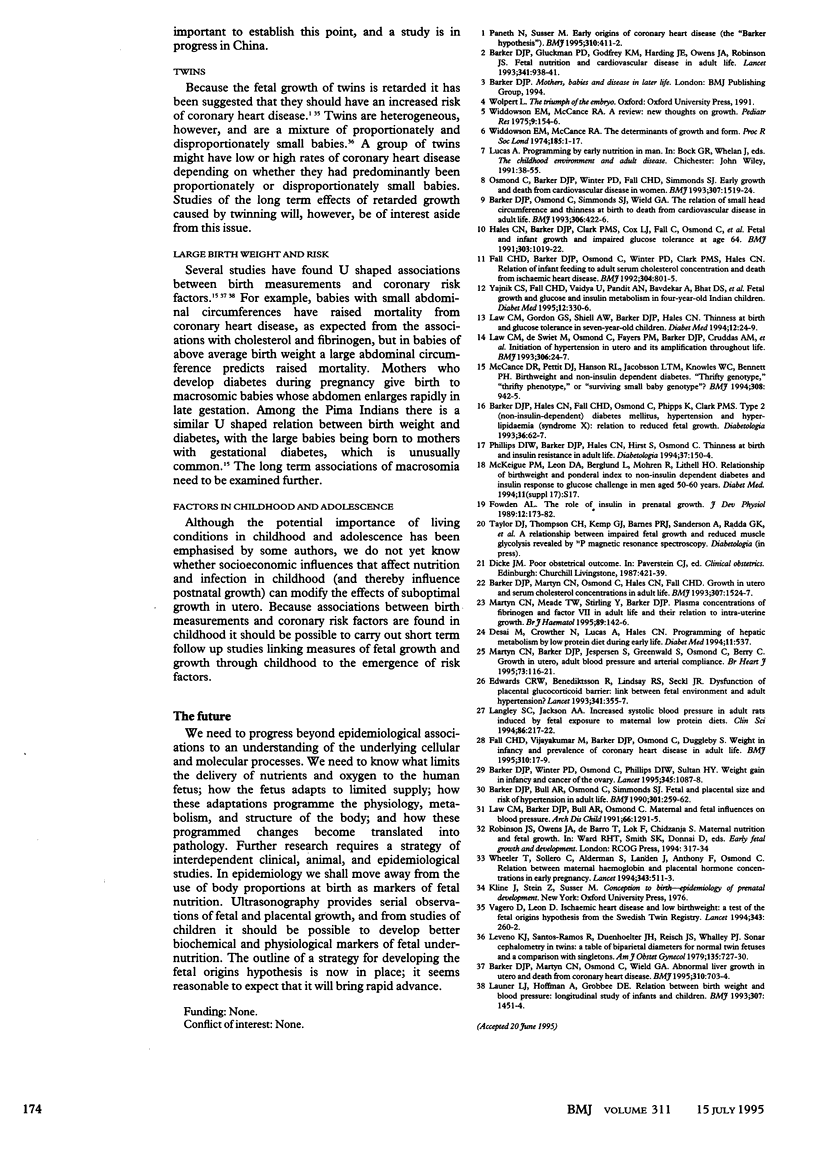Abstract
The fetal origins hypothesis states that fetal undernutrition in middle to late gestation, which leads to disproportionate fetal growth, programmes later coronary heart disease. Animal studies have shown that undernutrition before birth programmes persisting changes in a range of metabolic, physiological, and structural parameters. Studies in humans have shown that men and women whose birth weights were at the lower end of the normal range, who were thin or short at birth, or who were small in relation to placental size have increased rates of coronary heart disease. We are beginning to understand something of the mechanisms underlying these associations. The programming of blood pressure, insulin responses to glucose, cholesterol metabolism, blood coagulation, and hormonal settings are all areas of active research.
Full text
PDF



Selected References
These references are in PubMed. This may not be the complete list of references from this article.
- Barker D. J., Bull A. R., Osmond C., Simmonds S. J. Fetal and placental size and risk of hypertension in adult life. BMJ. 1990 Aug 4;301(6746):259–262. doi: 10.1136/bmj.301.6746.259. [DOI] [PMC free article] [PubMed] [Google Scholar]
- Barker D. J., Gluckman P. D., Godfrey K. M., Harding J. E., Owens J. A., Robinson J. S. Fetal nutrition and cardiovascular disease in adult life. Lancet. 1993 Apr 10;341(8850):938–941. doi: 10.1016/0140-6736(93)91224-a. [DOI] [PubMed] [Google Scholar]
- Barker D. J., Hales C. N., Fall C. H., Osmond C., Phipps K., Clark P. M. Type 2 (non-insulin-dependent) diabetes mellitus, hypertension and hyperlipidaemia (syndrome X): relation to reduced fetal growth. Diabetologia. 1993 Jan;36(1):62–67. doi: 10.1007/BF00399095. [DOI] [PubMed] [Google Scholar]
- Barker D. J., Martyn C. N., Osmond C., Hales C. N., Fall C. H. Growth in utero and serum cholesterol concentrations in adult life. BMJ. 1993 Dec 11;307(6918):1524–1527. doi: 10.1136/bmj.307.6918.1524. [DOI] [PMC free article] [PubMed] [Google Scholar]
- Barker D. J., Martyn C. N., Osmond C., Wield G. A. Abnormal liver growth in utero and death from coronary heart disease. BMJ. 1995 Mar 18;310(6981):703–704. doi: 10.1136/bmj.310.6981.703. [DOI] [PMC free article] [PubMed] [Google Scholar]
- Barker D. J., Osmond C., Simmonds S. J., Wield G. A. The relation of small head circumference and thinness at birth to death from cardiovascular disease in adult life. BMJ. 1993 Feb 13;306(6875):422–426. doi: 10.1136/bmj.306.6875.422. [DOI] [PMC free article] [PubMed] [Google Scholar]
- Barker D. J., Winter P. D., Osmond C., Phillips D. I., Sultan H. Y. Weight gain in infancy and cancer of the ovary. Lancet. 1995 Apr 29;345(8957):1087–1088. doi: 10.1016/s0140-6736(95)90821-8. [DOI] [PubMed] [Google Scholar]
- Edwards C. R., Benediktsson R., Lindsay R. S., Seckl J. R. Dysfunction of placental glucocorticoid barrier: link between fetal environment and adult hypertension? Lancet. 1993 Feb 6;341(8841):355–357. doi: 10.1016/0140-6736(93)90148-a. [DOI] [PubMed] [Google Scholar]
- Fall C. H., Barker D. J., Osmond C., Winter P. D., Clark P. M., Hales C. N. Relation of infant feeding to adult serum cholesterol concentration and death from ischaemic heart disease. BMJ. 1992 Mar 28;304(6830):801–805. doi: 10.1136/bmj.304.6830.801. [DOI] [PMC free article] [PubMed] [Google Scholar]
- Fall C. H., Vijayakumar M., Barker D. J., Osmond C., Duggleby S. Weight in infancy and prevalence of coronary heart disease in adult life. BMJ. 1995 Jan 7;310(6971):17–19. doi: 10.1136/bmj.310.6971.17. [DOI] [PMC free article] [PubMed] [Google Scholar]
- Fowden A. L. The role of insulin in prenatal growth. J Dev Physiol. 1989 Oct;12(4):173–182. [PubMed] [Google Scholar]
- Hales C. N., Barker D. J., Clark P. M., Cox L. J., Fall C., Osmond C., Winter P. D. Fetal and infant growth and impaired glucose tolerance at age 64. BMJ. 1991 Oct 26;303(6809):1019–1022. doi: 10.1136/bmj.303.6809.1019. [DOI] [PMC free article] [PubMed] [Google Scholar]
- Langley S. C., Jackson A. A. Increased systolic blood pressure in adult rats induced by fetal exposure to maternal low protein diets. Clin Sci (Lond) 1994 Feb;86(2):217–121. doi: 10.1042/cs0860217. [DOI] [PubMed] [Google Scholar]
- Launer L. J., Hofman A., Grobbee D. E. Relation between birth weight and blood pressure: longitudinal study of infants and children. BMJ. 1993 Dec 4;307(6917):1451–1454. doi: 10.1136/bmj.307.6917.1451. [DOI] [PMC free article] [PubMed] [Google Scholar]
- Law C. M., Barker D. J., Bull A. R., Osmond C. Maternal and fetal influences on blood pressure. Arch Dis Child. 1991 Nov;66(11):1291–1295. doi: 10.1136/adc.66.11.1291. [DOI] [PMC free article] [PubMed] [Google Scholar]
- Law C. M., Gordon G. S., Shiell A. W., Barker D. J., Hales C. N. Thinness at birth and glucose tolerance in seven-year-old children. Diabet Med. 1995 Jan;12(1):24–29. doi: 10.1111/j.1464-5491.1995.tb02057.x. [DOI] [PubMed] [Google Scholar]
- Law C. M., de Swiet M., Osmond C., Fayers P. M., Barker D. J., Cruddas A. M., Fall C. H. Initiation of hypertension in utero and its amplification throughout life. BMJ. 1993 Jan 2;306(6869):24–27. doi: 10.1136/bmj.306.6869.24. [DOI] [PMC free article] [PubMed] [Google Scholar]
- Leveno K. J., Santos-Ramos R., Duenhoelter J. H., Reisch J. S., Whalley P. J. Sonar cephalometry in twins: a table of biparietal diameters for normal twin fetuses and a comparison with singletons. Am J Obstet Gynecol. 1979 Nov 15;135(6):727–730. doi: 10.1016/0002-9378(79)90382-x. [DOI] [PubMed] [Google Scholar]
- Martyn C. N., Meade T. W., Stirling Y., Barker D. J. Plasma concentrations of fibrinogen and factor VII in adult life and their relation to intra-uterine growth. Br J Haematol. 1995 Jan;89(1):142–146. doi: 10.1111/j.1365-2141.1995.tb08920.x. [DOI] [PubMed] [Google Scholar]
- McCance D. R., Pettitt D. J., Hanson R. L., Jacobsson L. T., Knowler W. C., Bennett P. H. Birth weight and non-insulin dependent diabetes: thrifty genotype, thrifty phenotype, or surviving small baby genotype? BMJ. 1994 Apr 9;308(6934):942–945. doi: 10.1136/bmj.308.6934.942. [DOI] [PMC free article] [PubMed] [Google Scholar]
- McCance R. A., Widdowson E. M. The determinants of growth and form. Proc R Soc Lond B Biol Sci. 1974 Jan 22;185(1078):1–17. doi: 10.1098/rspb.1974.0001. [DOI] [PubMed] [Google Scholar]
- Osmond C., Barker D. J., Winter P. D., Fall C. H., Simmonds S. J. Early growth and death from cardiovascular disease in women. BMJ. 1993 Dec 11;307(6918):1519–1524. doi: 10.1136/bmj.307.6918.1519. [DOI] [PMC free article] [PubMed] [Google Scholar]
- Paneth N., Susser M. Early origin of coronary heart disease (the "Barker hypothesis") BMJ. 1995 Feb 18;310(6977):411–412. doi: 10.1136/bmj.310.6977.411. [DOI] [PMC free article] [PubMed] [Google Scholar]
- Phillips D. I., Barker D. J., Hales C. N., Hirst S., Osmond C. Thinness at birth and insulin resistance in adult life. Diabetologia. 1994 Feb;37(2):150–154. doi: 10.1007/s001250050086. [DOI] [PubMed] [Google Scholar]
- Vågerö D., Leon D. Ischaemic heart disease and low birth weight: a test of the fetal-origins hypothesis from the Swedish Twin Registry. Lancet. 1994 Jan 29;343(8892):260–263. doi: 10.1016/s0140-6736(94)91112-6. [DOI] [PubMed] [Google Scholar]
- Wheeler T., Sollero C., Alderman S., Landen J., Anthony F., Osmond C. Relation between maternal haemoglobin and placental hormone concentrations in early pregnancy. Lancet. 1994 Feb 26;343(8896):511–513. doi: 10.1016/s0140-6736(94)91461-3. [DOI] [PubMed] [Google Scholar]
- Widdowson E. M., McCance R. A. A review: new thoughts on growth. Pediatr Res. 1975 Mar;9(3):154–156. doi: 10.1203/00006450-197503000-00010. [DOI] [PubMed] [Google Scholar]
- Yajnik C. S., Fall C. H., Vaidya U., Pandit A. N., Bavdekar A., Bhat D. S., Osmond C., Hales C. N., Barker D. J. Fetal growth and glucose and insulin metabolism in four-year-old Indian children. Diabet Med. 1995 Apr;12(4):330–336. doi: 10.1111/j.1464-5491.1995.tb00487.x. [DOI] [PubMed] [Google Scholar]


